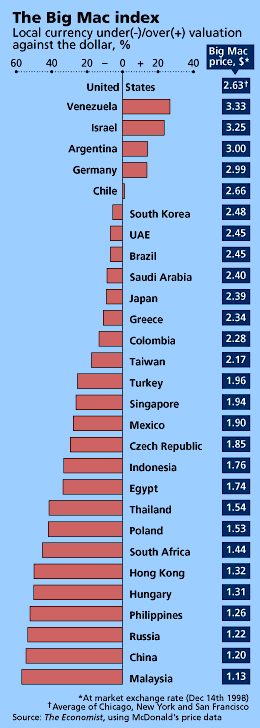Revisiting The Big Mac Economics
Post on: 16 Март, 2015 No Comment

Revisiting The Big Mac Economics
A few months back, The Grey Chronicles presented a post on the BigMac Index: A Compendium. While browsing the old issues of Asiaweek . I came across a similar graphical analysis whereby the price of McDonalds Big Mac hamburgers were compared in ten cities. Recalling that I have written a post on this, a revisit would seemingly be in order.
The Index is used as a method of predicting exchange rate movements. Why? Because the rate between two currencies should naturally adjust so that the Big Mac cost the same in both the US Dollar and whatever currency we are comparing it to. The Big Mac was chosen because the Burger is basically the same wherever you go and more importantly, you can buy the same tasty Big Mac almost anywhere in the world.
Presented below is a comparison of the foreign exchange increases versus the BigMac price increases in eight countries. Although the Asiaweek (1993 ) version included Pakistan and India, Big Mac prices were excluded for these countries in The Economist (2009 ) tabulation for the simple reason of a similar burger-to-burger (or apple-to-apple) comparison. In these particular countries, burgers are usually made with beef, while all others used pork. Also, the Asiaweek edition of Big Mac economics presented were nominally based on the capital cities of the respective countries; while The Economist version cited the names of the countries.
Comparative Exchange Rates and Big Mac Price Increases, 1993 v. 2009
With the exception of four countries, particularly Indonesia, Japan, Singapore and Thailand, it can generally be observed that a positive per cent change in the exchange rate of dollar to local currency, also increases the Big Mac prices. The term generally was used here only for comparison using a limited number of samples (n=8). It cannot be, however, ascertained that the increases in Big Macs selling prices for respective countries were caused by a he depreciation of the local currency vis-a-vis the dollar.
Take for example, Japan and Singapore: although the respective local currencies appreciated against the dollar, the Big Mac prices still went up. Notable of which was in Singapore, where Big Mac prices shoot up almost 50%, probably because of high rent prices of store space? Meanwhile, in Indonesia and Thailand, the respective local currencies also depreciated from 1993 to 2009, just like in Australia, Hong Kong, Malaysia and the Philippines, yet the Big Mac prices decreased by about 6% or so.
Moreover, taking Hong Kong as an example, even though the exchange rate very minimally (0.13%) changed between 1993 and 2009, yet the Big Mac price there increased almost 50% from the previous $1.15 to $1.72!
In the case of the Philippines, the dollar-to-peso exchange increased as much as 90%, yet the Big Mac prices increase in the country is almost similar to what Malaysians had to spend. The exchange rate in the Philippines changed mid-July 1997, on the onset of the Asian Financial Crises, from ₱26.4 to ₱28.772, broke the ₱40:$1 on 18 December 1997; ₱45:$1 on 27 July 2000; ₱50:$1 on 27 October 2000; and ₱55:$1 on 19 January 2001 (Rates from OANDA FXHistory ).
It has been said that the joke, labeled burgernomics by some, was meant to be humorous, but there can also be a lot of truth in humor. Yet in the foregoing analysis, there is no semblance of the truth to the humor. As some economists previously pointed out. The Big Mac Index does have its shortcomings. A Big Macs price reflects more than just the cost of bread and meat and vegetables. It also reflects non-tradeable elements such as rent and labor.
The usual disclaimer applies that I am not an economist. This post is just for the humor of burgernomics or an exercise of freakonomics, a term coined by Steve D. Levitt (Scheiber, 2007 ) said:
The simple fact is that its hard to do good research To the extent that you can do interesting research that teaches us something about the world, and entertains along the way, thats not so bad.
Anyway, the Big Mac is not the staple food in most Asian countries, yet. Rice is.
Notes:
McDonalds and Big Mac are registered trademarks of the McDonalds Corp. and its affiliates.
Asiaweek (1993). The Year In Hamburgers: Price of a McDonalds Big Mac. Hong Kong: Asiaweek . Special Issue. December 1992-January 1993. pp. 16, 20. back to text .
The Economist (2009). Big Mac index. London: The Economist . 09 February 2009. Click here for graphic image. back to text
Scheiber, Noam (2007). Freaks and Geeks. Washington: The New Republic . 236: 4810. 02 April 2007. p. 31. back to text .
Disclaimer: The posts herein do not necessarily represent any organizations positions, strategies or opinions. Read the full version of self-imposed rules for this blog: A New Year; New Rules. Unless otherwise expressly stated, the posts are licensed under a Creative Commons Attribution-Noncommercial-No Derivative Works 3.0 License.
Comments are moderated to keep the discussion relevant and civil. Readers are responsible for their own statements.














